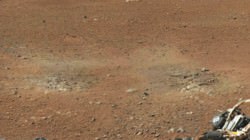Doesn’t Gale Crater look lovely this time of year? This is the first 360-degree panorama of color images taken by Curiosity’s color Mast Camera. The individual images used in this first panorama may only have been thumbnail-sized, but the effect is no less stunning.
(Click the image to panoramify.)
The images were acquired on August 9 EDT. Although taken during late afternoon at Gale crater, the individual images still had to be brightened as Mars only receives half the amount of sunlight that Earth does.
 Full-size 1200×1200 pixel images will be available at a later date.
Full-size 1200×1200 pixel images will be available at a later date.
The two grey patches in the foreground at left and right are the result of Curiosty’s sky crane rockets blasting the Martian surface. Scientists will be investigating these areas as they expose material that was previously hidden beneath Mars’ red dust.
The base of Gale Crater’s 3.4-mile (5.5 km) high central peak, named Mt. Sharp in honor of planetary science pioneer Robert P. Sharp, can be seen in the distance at center. (Check out an oblique view of a portion of Mt. Sharp acquired by HiRISE camera here.)
You can play with an interactive 360-degree panorama at the NASATech website, put together by John O’Connor, and if you look closely, visible is the full JPL logo on the middle right wheel — in Morse Code!
As always, you can find more news from the MSL mission here.
Image: NASA/JPL-Caltech


There’s a notable dark mountain on the horizon above the high gain antenna to the left.
I’m getting gready, will we get to see a moving image of the landscape?
This looks like the perfect landing spot. It appears to be almost perfectly flat.
LC
Aeolis Mons
Geez, they could have aimed the camera a few degrees higher… Still this is one sexy martian image!
There are more things in the universe than Mars…
that is true, but we do not have the money and technologie to explore further than mars.
Mars just got the most advanced rover ever built – it’s gonna be a the news a lot.
Christ, what is your problem?
Off you go then!
Anyone know what the approximate temperature is at this site?
The temperature range at Gale Crater is from −90°C to 0°C.
Thank you, thats quite a difference! this must be close to the equator of the planet!
It is – Gale Crater‘s latitude is 5.4°S.
Thanks for the images… I can’t get enough of them!
I took a closer look at the pebbles and chunks of soil that landed on Curiosity’s deck during the landing. Those images from the JPL web page on Sol 2. Those particles and chunks number in the hundreds? Then I took a look at some of the closeup images of the soil around Curiosity… and sure enough, there are marks where dust was disturbed by flying debris particles.
So when is Curiosity going to move? At some point the rover has to rove.
LC
The first drive will be carried out after the engineers have finished conducting tests to ensure that the rover is in a “safe state” before moving it beyond its original landing position.